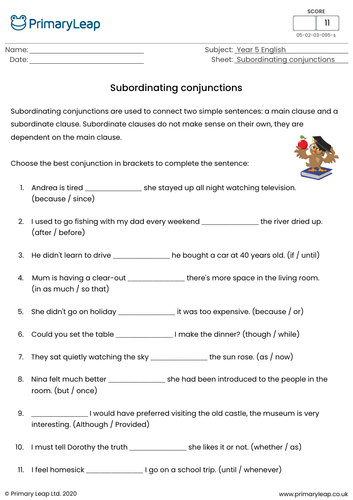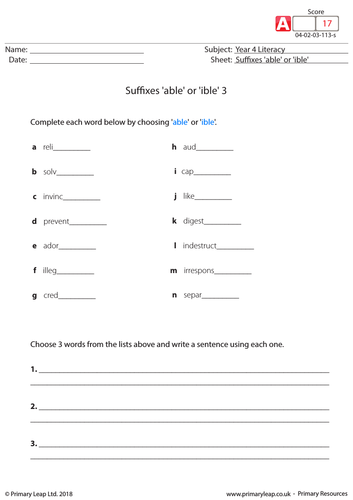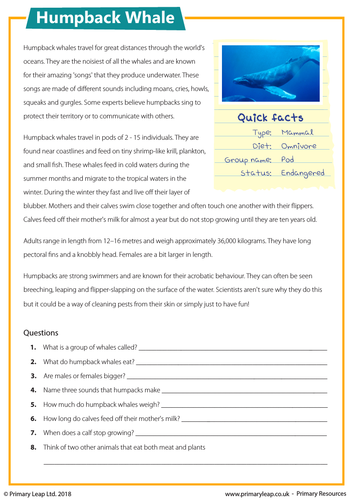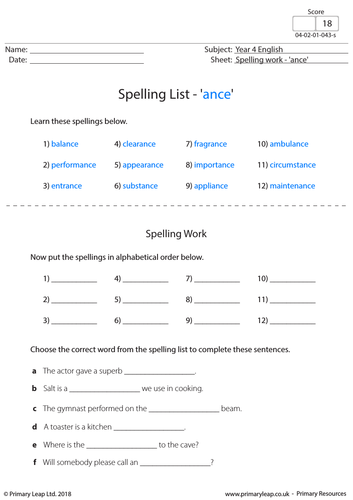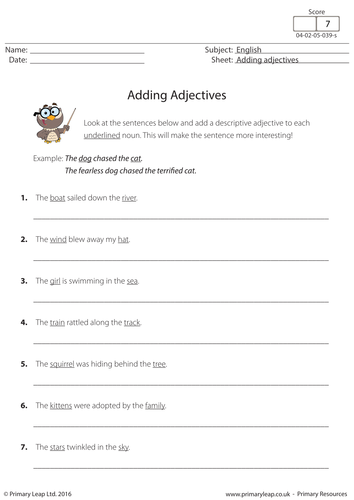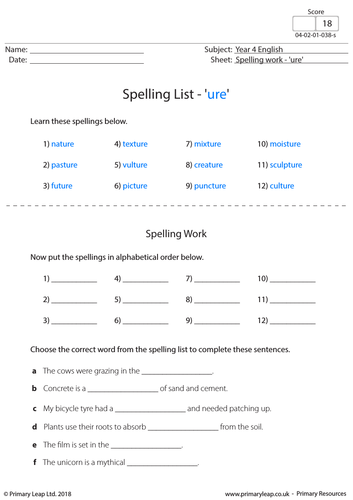506Uploads
481k+Views
218k+Downloads
English

KS2 English Worksheet: Suffix - 'tion' words
A suffix is a phonetic unit that is placed after a root word. This English resource focuses on the suffix: tion. Students complete the sentences by writing the correct word.
This worksheet was created by Lauren Savage @ Primary Leap

KS2 Reading Comprehension - Hummingbirds
This KS2 reading comprehension includes an information sheet about hummingbirds. Students read through the article and answer the accompanying study questions.
Find more resources at Primary Leap

KS2 English - Subordinating conjunctions
Subordinating conjunctions are used to connect two simple sentences: a main clause and a subordinate clause. Subordinate clauses do not make sense on their own, they are dependent on the main clause. This English activity asks students to choose the best conjunction in brackets to complete the sentences.
Resource created by Lauren Savage

Reading Comprehension - The Selfish Giant
Students are asked to read through a part taken from the book: The Selfish Giant by Oscar Wilde. There are comprehension, vocabulary, and discussion topics for students to complete. There is also a word search included.
Find more resources at Primary Leap

KS2 English - Coordinating conjunctions
Coordinating conjunctions are used to connect sentences, words and phrases. They act as a kind of glue, linking the text together to help the sentences flow smoothly. This English resource asks students to choose the best conjunction in brackets to complete the sentences.
Worksheet created by Primary Leap

Reading Comprehension - Autumn is the Time of Year
This poem is all about Autumn. Students are asked to read through the poem and answer the accompanying questions.

KS2 English Resource - Suffixes 'able' or 'ible'
A KS2 literacy worksheet focusing on the suffixes ‘able’ and ‘ible’. Students complete each word by choosing ‘able’ or ‘ible’.
This worksheet was created by Primary Leap

Making Inferences from Pictures 1
Inferences are what we figure out based on an experience. Helping students understand when information is implied, or not directly stated, will improve their skill in drawing conclusions and making inferences which is an essential skill in reading comprehension. This English resource shows 2 happy children using a laptop. Students are asked to look at the picture and then answer the questions, giving their reasons for each answer.
Find more resources at Primary Leap

KS2 Reading Comprehension - Humpback Whale
This year 5 English worksheet includes a short passage with facts about humpback whales and questions to follow.
This worksheet was created by Primary Leap

English Worksheet: Adverbs with Suffix - ly
This year 3 English resource is designed to encourage children to use adverbs with suffix - ly. Students write their own sentences using the words provided.
Additional worksheets, lesson plans, and interactive activities are available on Primary Leap.

Verb prefixes - dis and mis
A prefix is a group of letters added before a word to alter its meaning. The prefix ‘dis’ is generally used to make a word negative. The prefix ‘mis’ means badly, wrongly or incorrectly. This English resource asks students to choose the correct word to complete the sentence.
This worksheet was created by Lauren Savage

KS2 English Worksheet - Spellings 'ance'
A KS2 English resource including a list of 12 words ending with ‘ance’ for students to learn. There are exercises including putting the words in alphabetical order and choosing the correct word from the spelling list to complete the sentences.
This resource was created by Primary Leap

Adding Adjectives (1)
Students are asked to add a descriptive adjective to each underlined noun. This will make the sentences more interesting and is good practice for story writing.

Type of sentences: statement, command, question and exclamation
This worksheet was created by Primary Leap
A statement gives us information
e.g. the sky is blue.
A command tells us to do something
e.g. go and brush your teeth.
A question asks us something
e.g. how old are you?
An exclamation shows us that someone feels strongly about something
e.g. ouch!
Students read the sentences and write statement, command, question or exclamation next to each one. They also need to add the correct punctuation at the end of each sentence (., ?, !)

Making Inferences from Pictures 3
Inferences are what we figure out based on an experience. Helping students understand when information is implied, or not directly stated, will improve their skill in drawing conclusions and making inferences which is an essential skill in reading comprehension. Students are asked to look at the picture and then answer the questions.
Find more resources at Primary Leap

To, Too or Two?
Use to as a preposition before a noun or as an infinitive before a verb. Use too as a synonym for also or to indicate excessiveness before a verb. Use two to spell out the number 2. Students choose to, too or two to complete each sentence.

KS2 English worksheet: Phonics - 'ire' and 'ear' words
This English worksheet asks students to complete the sentences by choosing the correct word from the word bank. This resource focuses on the phonics ‘ire’ and ‘ear’.
This worksheet was created by Lauren Savage @ Primary Leap

Match the Contractions - English Resource
A contraction is a word made by shortening and combining two words. Words like can’t (can + not) and don’t (do + not) are contractions. Students draw a line to match the contractions.
Additional worksheets, lesson plans, and interactive activities are available on Primary Leap.

KS2 English Resource - Spellings 'ure'
A KS2 English resource including a list of 12 words with ‘ure’ for students to learn. There are exercises including putting the words in alphabetical order and choosing the correct word from the spelling list to complete the sentences.
This resource was created by Primary Leap

Common Exception Words 2
Common exception words are ‘tricky words’ to read. Some exception words are used very frequently, which is why children should start reading and writing them at an early age. This English resource helps students practise reading and writing common exception words. They are asked to read the word and use it in a sentence.
Find more resources at Primary Leap



